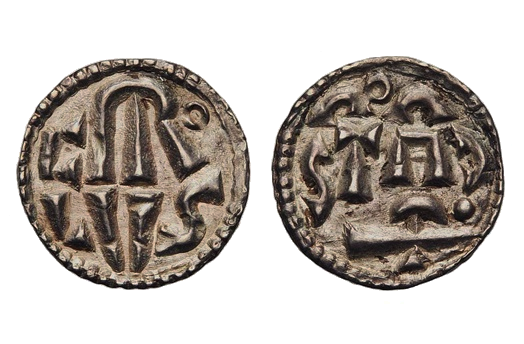
about ancient nomos
Ancient Nomos Art is a museum of galleries exhibiting ancient coins and ancient mint maps. The coin gallery displays the diverse art and history of hand-crafted ancient Greek, Roman, Byzantine, Persian and Medieval coinage. The ancient mints mapping gallery features Greek, Roman, Byzantine, Asia Minor and Medieval mint city regions and territories. Visitor's are welcome to explore, study and enjoy Ancient Nomos Art.

Medieval, France – 771 AD
Charlemagne
From Ancient Galleries

Obverse: Large legend naming King Charles I as, CARo / LVS (AR ligatured) in two lines across the field.
Reverse: Legend naming Dorestad mint as, DOR / STAD in two lines across upper field; battle ax below.
LEGEND
Obverse:
![]()
Large legend naming King Charles I as, CARo / LVS (AR ligatured) in two lines across the entire field; beaded border.
Reverse:
![]()
Large legend naming the mint city of Dorestad as, DOR / STAD (DR as crescents) in two lines across the upper field; single-headed battle ax and haft below the legend; pellet in field to the right; beaded border.
HISTORICAL NOTE:
Charlemagne (Charles I) “the Great” was the son of Pépin ‘le Bref’ (the Short), founder of the Carolingian Empire. Charlemagne was born in the Aachen/Liège region of West Germany along the north Rhine River, in 747 AD, according to Annales Petaviani. The Aachen/Liège region was the center of the medieval Merovingian and Carolingian dynasties. His father Pépin was able to successfully defeat the last of the Merovingian kings. Charlemagne was then able to expand their Kingdom to include all of West Francia. West Francia would soon after become the most powerful medieval empire since the decline of the Roman Empire. After the death of his father Pépin, Charles I was formally proclaimed the Holy Roman Emperor by Pope Leo III on Christmas Day in the year 800 AD. However, the rare silver denier above was issued nearly 25 years after his coronation by the Pope, a testament to his early economic reforms and expansion. In addition, his Holy Roman Emperor status greatly facilitated the circulation of the denier denomination coinage. The Carolingian denier currency would quickly become widely accepted and the most circulated coinage type in Europe since the Roman denarius, facilitating the rapidly expanding early medieval economies that were trading throughout Western Europe and Asia.
HISTORICAL INFORMATION COMING SOON
The historical information for the above early medieval Charlemagne silver denier exhibits are currently in review. Please come back to visit this item again in the next few weeks.
Thank you for your patience and for visiting ANAM.
DOCUMENTATION
Value: AR Denier – Class 2 coinage. Metal: AR Silver. Weight: 1.23 grams. Mint: Dorestad (Wijk-bij-Duurstede) mint. Date: Struck 771-793/4 AD.
Attribution: S. Coupland, Charlemagne 3; Depeyrot 410; M&G 699 (variation); Medieval European Coinage 1, 724 (variation); M. Prou, Monnaies Carollingiennes, 57 (variation); Lanz, 124, 327 (this coin); Provient de Riechmann, Halle, 1933.
Legend, Documentation and Attribution
